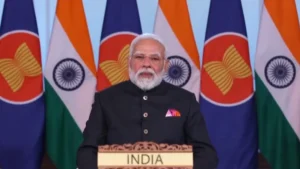Prime Minister Narendra Modi’s decision to attend the 47th Modi ASEAN Summit virtually has sparked significant diplomatic discussions across the international community. The Indian leader will participate in the summit being held in Kuala Lumpur between October 26-28 through online channels, citing ongoing Diwali celebrations in India as the reason for his physical absence. This marks a critical moment in India’s engagement with Southeast Asian nations and raises questions about the country’s broader diplomatic strategy.
Foreign Minister Subrahmanyam Jaishankar will represent India physically at the Malaysia summit, ensuring the country maintains its presence at this important regional gathering. The Modi ASEAN Summit represents a significant platform for discussing regional cooperation, economic integration, and security challenges facing the Indo-Pacific region.
 Also Read: Modi ASEAN Summit
Also Read: Modi ASEAN Summit
Other: Rethink of interlocutor appointment
The Deepavali Factor: Cultural Considerations in Diplomacy
Malaysian Prime Minister Anwar Ibrahim confirmed Modi’s virtual participation after receiving a phone call from the Indian leader, where Modi explained that Deepavali celebrations were still ongoing in India. This cultural consideration highlights the importance of domestic festivities in shaping India’s diplomatic calendar.
In his social media statement, Modi expressed warm regards to Prime Minister Anwar Ibrahim, congratulating Malaysia on its ASEAN Chairmanship and conveying best wishes for the success of the upcoming summits. The decision to attend the Modi ASEAN Summit virtually demonstrates India’s commitment to maintaining strong regional ties while respecting important domestic cultural events.
No Trump Meeting: Geopolitical Implications
The virtual attendance at the Modi ASEAN Summit effectively rules out any possibility of a face-to-face meeting between Prime Minister Modi and US President Donald Trump, who is travelling to Kuala Lumpur for the summit. This marks only the second time since becoming Prime Minister that Modi has skipped this important gathering of Southeast Asian leaders, with the previous instance occurring in 2022 when then-Vice President Jagdeep Dhankhar represented India in Cambodia.
Modi’s decision to avoid a premature meeting with President Trump appears strategic, as bilateral ties between India and the United States remain uncertain until a comprehensive trade agreement is finalised. The absence of direct talks at the Modi ASEAN Summit underscores the delicate nature of current India-US relations.
Trade Tensions: The Russian Oil Controversy
The primary obstacle in India-US trade negotiations centres on New Delhi’s continued imports of Russian crude oil. In August, the Trump administration imposed a 25% additional tariff on Indian exports as a penalty for Russian oil purchases, bringing total duties to 50% and severely straining bilateral relations.
President Trump has repeatedly claimed that Prime Minister Modi assured him India would stop buying Russian oil, though India’s foreign ministry has denied knowledge of such conversations. This disconnect between Washington and New Delhi has created significant friction in trade talks.
Russia currently accounts for approximately 35% of India’s total oil imports, making it the country’s top supplier. India’s energy security concerns remain paramount, as the country seeks to balance domestic energy demands with international pressure.
 The Economic Stakes: Tariffs and Trade Volumes
The Economic Stakes: Tariffs and Trade Volumes
Bilateral trade between India and the United States reached a record $132.2 billion in the fiscal year ending March 2025, representing an increase of more than 10% from the previous year. India’s exports to America jumped 11.6% to $86.51 billion, while imports from the United States rose 8% to $45.69 billion.
Under a potential trade deal being discussed, Washington may reduce tariffs on Indian exports to 15-16% from the current 50%, while New Delhi may agree to gradually wind down its imports of Russian oil. These negotiations represent critical economic interests for both nations.
The Modi ASEAN Summit takes place against this backdrop of trade uncertainty, with India carefully navigating its relationships with both Western powers and traditional energy suppliers.
India’s Strategic Autonomy: Balancing Act
Indian Commerce and Industry Minister Piyush Goyal emphasised that India will not rush into signing any trade agreements and will reject conditions from partner countries that restrict its trading choices. This statement reflects New Delhi’s commitment to maintaining strategic autonomy in its foreign policy decisions.
Goyal stressed that India’s approach to trade negotiations is not driven by pressure to meet immediate targets, but by a long-term vision. The Modi ASEAN Summit attendance pattern demonstrates this measured approach to international engagement.
ASEAN-India Relations: A Comprehensive Strategic Partnership
Despite Modi’s virtual presence at the Modi ASEAN Summit, India remains deeply committed to strengthening its ties with Southeast Asian nations. During his virtual address to the summit, Prime Minister Modi stated that the India-ASEAN partnership has seen steady progress even in this era of uncertainties, emerging as a robust foundation for global stability and development.
The 47th ASEAN Summit is being held under Malaysia’s chairmanship with the theme “Inclusivity and Sustainability,” and over 30 heads of state and government are expected to discuss issues such as regional peace, economic resilience, and inclusive growth.
India announced that 2026 will be designated as the ASEAN-India Maritime Year, highlighting the growing cooperation in maritime security and the blue economy. This initiative demonstrates India’s continued commitment to regional partnerships despite the virtual format of participation at the Modi ASEAN Summit.
 Future Outlook: Diplomatic Manoeuvring Ahead
Future Outlook: Diplomatic Manoeuvring Ahead
The Modi ASEAN Summit attendance decision reflects India’s careful diplomatic calculations during a period of significant geopolitical tension. Sources suggest that the two leaders will likely meet only after a bilateral trade agreement between India and the United States is signed and sealed.
India’s major refiners are now preparing to sharply cut their purchases of Russian crude following new US sanctions targeting Moscow’s top energy producers, indicating potential movement toward resolving the trade impasse.
The virtual participation at the Modi ASEAN Summit allows India to maintain its regional commitments while avoiding premature bilateral discussions that could prove counterproductive. As trade negotiations continue between Washington and New Delhi, the international community watches closely to see how these two major democracies navigate their complex economic and strategic relationship.
Conclusion
The Modi ASEAN Summit virtual attendance represents more than a scheduling decision driven by Diwali celebrations. It reflects India’s strategic approach to managing multiple diplomatic priorities simultaneously—maintaining strong ASEAN partnerships, protecting energy security interests, and negotiating favourable trade terms with the United States. As External Affairs Minister Jaishankar represents India physically in Kuala Lumpur, the Modi ASEAN Summit continues to serve as an important platform for regional cooperation, even as bilateral tensions with Washington remain unresolved. The coming months will reveal whether this diplomatic distance creates space for productive negotiations or further complicates an already strained relationship between the world’s oldest and largest democracies.

